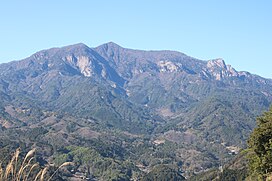| Mount Ōkueyama | |
|---|---|
 | |
| Highest point | |
| Elevation | 1,643 m (5,390 ft) |
| Coordinates | 32°44′16″N 131°30′47″E / 32.7378°N 131.5131°E |
| Geography | |
| Location | Kyushu, Japan |
| Geology | |
| Mountain type | stratovolcano |
| Last eruption | ~13.7 Ma |
Mount Ōkueyama (大崩山), also known as Mount Ōkue, is a volcanic mountain on the Japanese island of Kyushu. Part of an ancient volcanic formation known as the Okueyama Volcano-plutonic Complex, [1] Mount Ōkueyama (and possibly several nearby volcanoes) [2] experienced a massive eruption ~13.7 million years before present (13.7 Ma); it has been postulated that this eruption measured 8 on the Volcanic Explosivity Index, making the Ōkueyama eruption larger than any eruption in recorded history. [2] The mountain is now considered to be extinct. [1]
In 1990, the area around the mountain was designated a Forest Ecosystem Reserve, [3] and In 2017 Mount Ōkueyama was declared part of a UNESCO biosphere reserve, the Sobo, Katamuki and Okue Biosphere Reserve. [4] [5]
The area is managed by the Forestry Agency of Japan. [3]
See also
References
- ^ a b Takahashi, Masaki. Subsurface Structure of Miocene Large-scale Caldera Cluster: Illustrated Descriptions of Geology of the Okueyama Volcano-plutonic Complex, Southwest Japan. Received November 16, 2013 URL: https://www.chs.nihon-u.ac.jp/institute/nature/kiyou/2014/pdf/2_11.pdf
- ^ a b Daisuke, Miura; Yutaka, Wada (2007). "Middle Miocene ash-flow calderas at the compressive margin of southwest Japan arc: Review and synthesis". The Journal of the Geological Society of Japan. 113 (7): 283–295. doi:10.5575/geosoc.113.283. Retrieved 8 August 2019.
- ^ a b "Area around Mt. Sobosan, Mt. Katamukiyama, and Mt. Okueyama". Protected Planet. Retrieved 2019-08-07.
- ^ "23 new sites added to UNESCO's World Network of Biosphere Reserves". UNESCO. 2017-06-14. Retrieved 2019-08-07.
- ^ "Two sites in Japan to be added to UNESCO biosphere reserves". The Japan Times Online. 2017-06-14. ISSN 0447-5763. Retrieved 2019-08-07.
| Mount Ōkueyama | |
|---|---|
 | |
| Highest point | |
| Elevation | 1,643 m (5,390 ft) |
| Coordinates | 32°44′16″N 131°30′47″E / 32.7378°N 131.5131°E |
| Geography | |
| Location | Kyushu, Japan |
| Geology | |
| Mountain type | stratovolcano |
| Last eruption | ~13.7 Ma |
Mount Ōkueyama (大崩山), also known as Mount Ōkue, is a volcanic mountain on the Japanese island of Kyushu. Part of an ancient volcanic formation known as the Okueyama Volcano-plutonic Complex, [1] Mount Ōkueyama (and possibly several nearby volcanoes) [2] experienced a massive eruption ~13.7 million years before present (13.7 Ma); it has been postulated that this eruption measured 8 on the Volcanic Explosivity Index, making the Ōkueyama eruption larger than any eruption in recorded history. [2] The mountain is now considered to be extinct. [1]
In 1990, the area around the mountain was designated a Forest Ecosystem Reserve, [3] and In 2017 Mount Ōkueyama was declared part of a UNESCO biosphere reserve, the Sobo, Katamuki and Okue Biosphere Reserve. [4] [5]
The area is managed by the Forestry Agency of Japan. [3]
See also
References
- ^ a b Takahashi, Masaki. Subsurface Structure of Miocene Large-scale Caldera Cluster: Illustrated Descriptions of Geology of the Okueyama Volcano-plutonic Complex, Southwest Japan. Received November 16, 2013 URL: https://www.chs.nihon-u.ac.jp/institute/nature/kiyou/2014/pdf/2_11.pdf
- ^ a b Daisuke, Miura; Yutaka, Wada (2007). "Middle Miocene ash-flow calderas at the compressive margin of southwest Japan arc: Review and synthesis". The Journal of the Geological Society of Japan. 113 (7): 283–295. doi:10.5575/geosoc.113.283. Retrieved 8 August 2019.
- ^ a b "Area around Mt. Sobosan, Mt. Katamukiyama, and Mt. Okueyama". Protected Planet. Retrieved 2019-08-07.
- ^ "23 new sites added to UNESCO's World Network of Biosphere Reserves". UNESCO. 2017-06-14. Retrieved 2019-08-07.
- ^ "Two sites in Japan to be added to UNESCO biosphere reserves". The Japan Times Online. 2017-06-14. ISSN 0447-5763. Retrieved 2019-08-07.